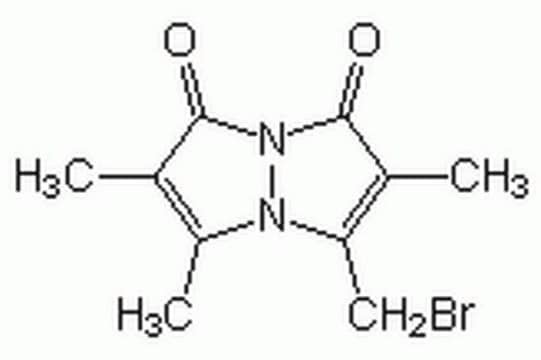05019
7-Diethylamino-3-[N-(2-maleimidoethyl)carbamoyl]coumarin
suitable for fluorescence, BioReagent, ≥97.0% (HPLC)
Synonym(s):
MDCC
Sign Into View Organizational & Contract Pricing
All Photos(1)
About This Item
Empirical Formula (Hill Notation):
C20H21N3O5
CAS Number:
Molecular Weight:
383.40
MDL number:
UNSPSC Code:
12352116
PubChem Substance ID:
NACRES:
NA.32
Recommended Products
product line
BioReagent
Quality Level
assay
≥97.0% (HPLC)
suitability
suitable for fluorescence
SMILES string
CCN(CC)c1ccc2C=C(C(=O)NCCN3C(=O)C=CC3=O)C(=O)Oc2c1
InChI
1S/C20H21N3O5/c1-3-22(4-2)14-6-5-13-11-15(20(27)28-16(13)12-14)19(26)21-9-10-23-17(24)7-8-18(23)25/h5-8,11-12H,3-4,9-10H2,1-2H3,(H,21,26)
InChI key
IXQPRUQVJIJUEB-UHFFFAOYSA-N
Application
7-Diethylamino-3-[N-(2-maleimidoethyl)carbamoyl]coumarin is utilized as a fluoresencent biological sensing device . Used for real-time measurements for the release of inorganic phosphates during enzymatic reaction when MDCC is conjugated to a mutant phosphate-binding protein . Also, utilized for intramolecular fluorescence energy transfer (FRET) experiments .
Thiol-reactive probe for protein labelling
Certificates of Analysis (COA)
Search for Certificates of Analysis (COA) by entering the products Lot/Batch Number. Lot and Batch Numbers can be found on a product’s label following the words ‘Lot’ or ‘Batch’.
Already Own This Product?
Find documentation for the products that you have recently purchased in the Document Library.
Customers Also Viewed
M Brune et al.
Biochemistry, 33(27), 8262-8271 (1994-07-12)
A probe has been developed that can rapidly measure micromolar concentrations of inorganic phosphate (Pi), in particular to follow the release of Pi in real time from enzymes such as phosphatases. Its application is described to investigate the mechanism of
Yu-Chih Tsai et al.
Biochemistry, 45(32), 9675-9687 (2006-08-09)
We show that T7 DNA polymerase exists in three distinct structural states, as reported by a conformationally sensitive fluorophore attached to the recognition (fingers) domain. The conformational change induced by a correct nucleotide commits the substrate to the forward reaction
Lyndon L E Salins et al.
Analytical and bioanalytical chemistry, 372(1), 174-180 (2002-04-10)
A sensing system for nickel based on the nickel binding protein (NBP) from Escherichia coli is shown to be feasible. The versatility of NBP was demonstrated by its use in three different assay formats. When the NBP binds nickel, it
Z H He et al.
The Journal of physiology, 501 ( Pt 1), 125-148 (1997-05-15)
1. The rate of appearance of inorganic phosphate (Pi) and hence the ATPase activity of rabbit psoas muscle in single permeabilized muscle fibres initially in rigor was measured following laser flash photolysis of the P3-1-(2-nitrophenyl)ethyl ester of ATP (NPE-caged ATP)
Jeremiah W Hanes et al.
Chemical communications (Cambridge, England), 47(8), 2273-2275 (2010-12-03)
This communication describes the development of a thiamin sensor based on the bacterial thiamin binding protein. A triple mutant (C48S, C50S, S62C) of TbpA was labeled on C62 with N-[2-(L-maleimidyl)ethyl]-7-(diethylamino)coumarin-3-carboxamide (MDCC). Thiamin binding to this protein reduced the coumarin fluorescence
Our team of scientists has experience in all areas of research including Life Science, Material Science, Chemical Synthesis, Chromatography, Analytical and many others.
Contact Technical Service















